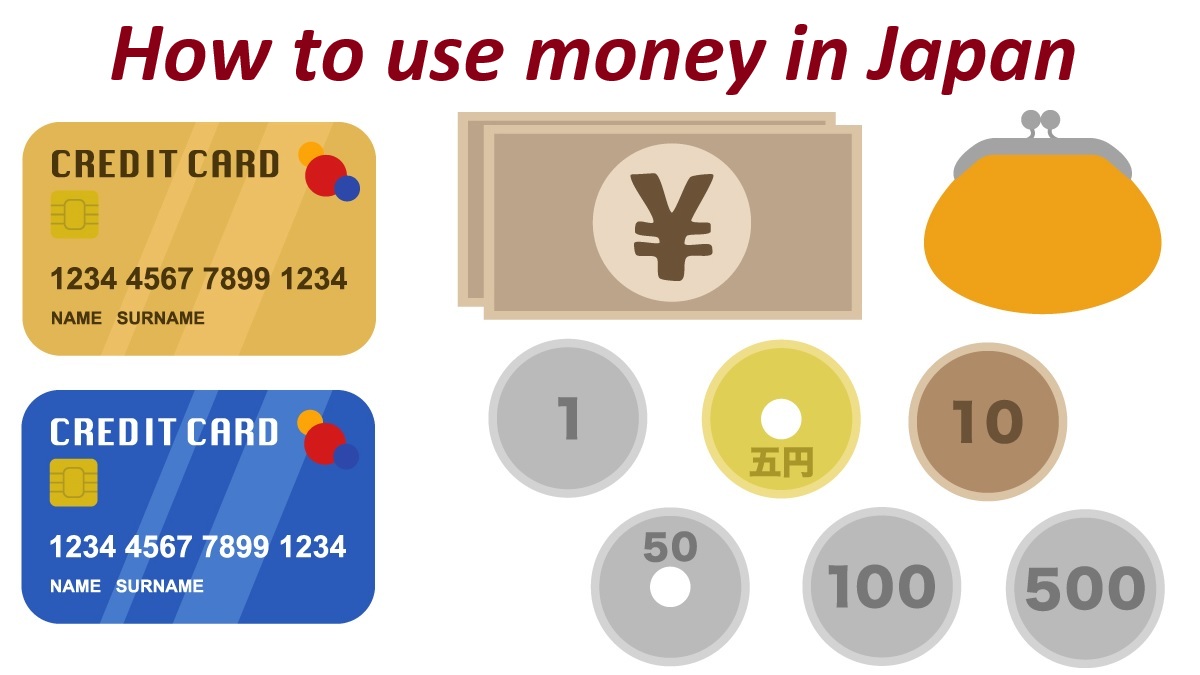How to use money in Japan
Japanese currency is "yen" and the currency symbol is "¥".
It is written as "円" in Kanji charachter.
("¥" is also used as the currency symbol of Chinese Yuan, but the sign is for Japanese yen in Japan.)
Yen is smaller unit than "US dollars" and "euro", and it is similar to "cent" of them.
Japan is called as underdeveloped country of electronic payment.
In fact, electronic payment in Japan accounts for only about 40% of a whole.
Cash is still the main method of payment in Japan.
For electronic payment, credit card is mainly used.
Recently, QR code payment and mobile payment are increasing, but they are managed by Japanese companies.
So, it will be hard for you to use them during the travel in Japan.
Therefore, when you travel around Japan, you need to prepare Japanese cash and credit cards.
By the way, traveler's check had ever been popular.
In Japan, it was finished selling in 2014.
Now probably, no shop handles it in Japan.
Japanese coins and bills
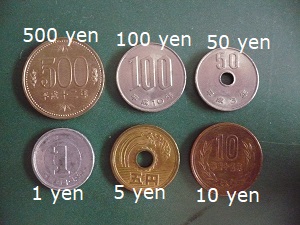
There are six kinds of Japanese coins.
They are 500 yen, 100 yen, 50 yen, 10 yen, 5 yen and 1 yen coins.
50 yen and 5 yen coins have a hole in the center.
I hear that these are rare in the world.
Because each one has its own characteristics, it is comparatively easy to distinguish them.
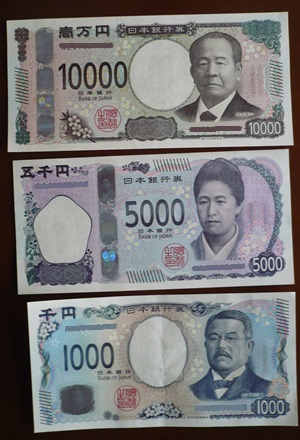
10,000 yen, 5,000 yen, and 1,000 yen bills are used as paper money.
These bills were issued in July, 2024.
In spite of the progress of the cashless society, previous bills were changed to these periodically.
To prevent forgery, various advanced technologies are used in them.
The figures on the bills are the following, and all of them are Japanese persons of culture in the 19th to 20th centuries.
- 10,000 yen : Shibusawa Eiichi (1840-1931), a great businessman called as the father of Japanese economy.
He established many banks, stock exchange, various schools, etc. first in Japan. - 5,000 yen : Tsuda Umeko (1864-1929), the first woman educator for female education in Japan.
She established the first school for girls in Japan. - 1,000 yen : Kitazato Shibasaburo (1853-1931), a physician and bacteriologist.
He developed the medical treatment for tetanus and diphtheria.
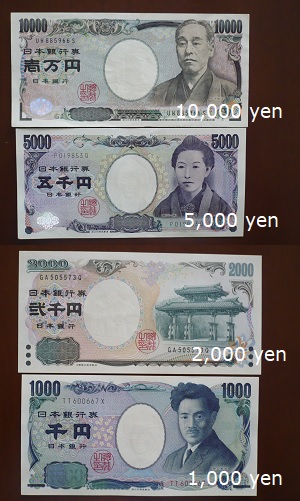
Previous bills are 10,000 yen, 5,000 yen, 2,000 yen and 1,000 yen.
2,000 yen bill was issued in 2000, and the other bills were issued in 2004.
The total number of issued 2,000 yen bills had been small, so we can't get them easily.
These bills will be also used for the time being.
The figures on the bills are the following, and only the figure of 2,000 yen bill is a historical building.
- 10,000 yen : Fukuzawa Yukichi (1835-1901), a scholar, an educator, a thinker.
- 5,000 yen : Higuchi Ichiyo (1872-1896), a woman novelist.
- 2,000 yen : Shureimon gate of Shuri Castle in Okinawa Prefecture.
- 1,000 yen : Noguchi Hideyo (1876-1928), a world‐class bacteriologist.
Money exchange
After you arrive in Japan, you can get Japanese cash at the following places.
There are the money exchange counters in the major international aitports.
Banks have been the reliable places of money exchange.
But recently, many of them outsource the service to outside specialty companies.
The followings are the companies.
The counters are in some banks and major facilities in the center of large city.
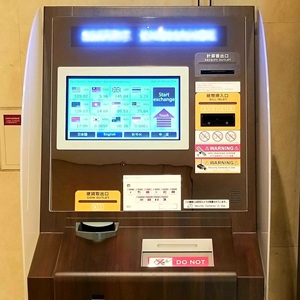
A Money Exchange Machine
Recently, Money Exchange Machines have been developed and the number is increasing.
It is like ATM and your foreign bills are changed to Japanese money automatically.
They are set in some convenience stores of 7-ELEVEN and FamilyMart in large cities.
And, the machines named SMART EXCHANGE are set in main airports, railway stations, big hotels, major retail stores, etc.
There is also the service to withdraw Japanese money by your credit card at ATM.
It is operated by the ATM of Seven Bank in the convenient store of 7-ELEVEN and the ATM of Japan Post Bank in the post office.
This may be the easiest way to get Japanese cash.
Credit card
Credit card is the main method of payment other than cash in Japan.
Visa, JCB, Mastercard are the popular brands in Japan.
JCB is Japanese brand and is popular for Japanese people.
It is also one of international brands.
The usage of these three brands account for more than 95% of the total in Japan.
The rest is American Express and Diners Club.
These are also international brands.
Discover Card is not issued in Japan.
But it has the business partnership with JCB, so it can be used in the shop handling JCB card.
Of course, some shops handle above five brands, but the others handle only a few of them.
You should check which of them you can use in the shop.
Recently, UnionPay is handled in big shops and convenience stores in large cities.
It is a Chinese brand, and it is for many tourists from China.
For contactless payment, the cards of Visa, JCB, Mastercard are available.
Of course, the cards must be for contactless payment.
(Japanese people often call the payment "Touch payment".)
Debit card
Debit card is not popular in Japan.
But the debit card by international brand of credit card such as Visa, JCB, Mastercard, American Express can be used like the credit card.
IC card for transportation
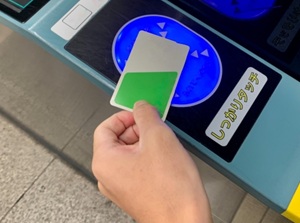
Passing the entrance gate by touching with the card
There is the IC card as pass for commuting to offices or schools by railway and bus.
It is a prepaid card and charging money is possible.
When you get on a train, you touch the entrance gate with the card and enter the platform.
After you get off the train, you touch the exit gate with the card and go out the station.
You need not buy the railway ticket, and the fare is collected from the card automatically.
When you touch with the card, the balance on your card is displyed on the gate.
Because the card can be used for various railway companies, it is convenient to travel around the city area.
(Caution : That is a contactless system, but contactless credit card is not available.)
In addition, it is available for shopping at convenience stores, vending machines, etc. and eating in various fast food restaurants.
So, this is also a convenient method to use money.
Many main railway companies sell the cards.
But the following cards are for foreign tourists and have the privilege.

